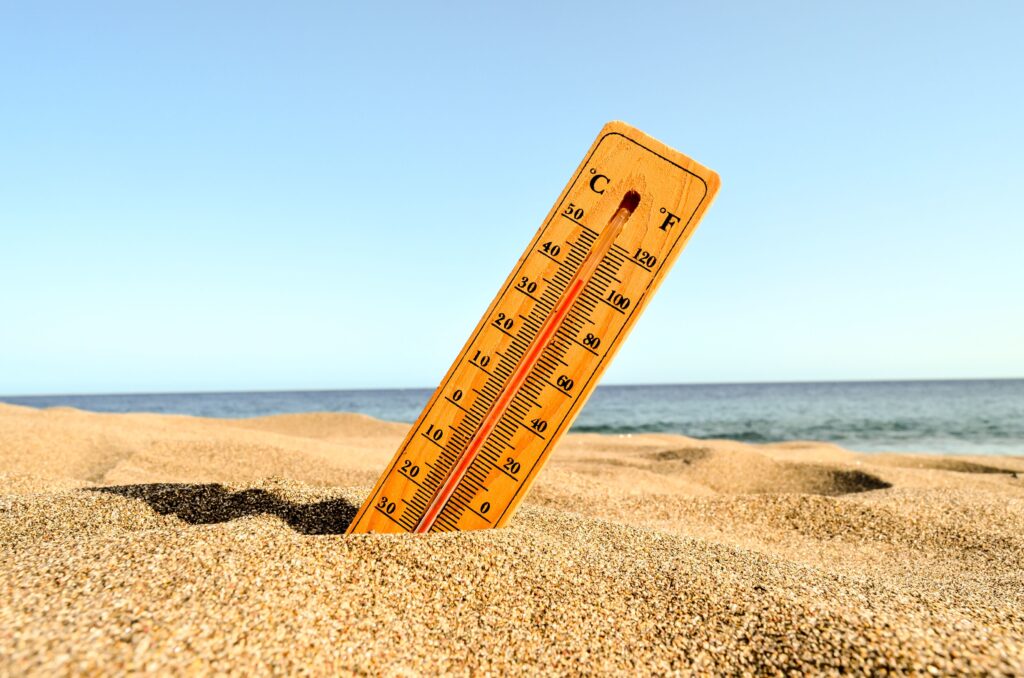
A fierce heatwave continues to grip northwest India, with temperatures surging to record-breaking highs across several states. The India Meteorological Department (IMD) has issued red alerts for Rajasthan, Punjab, Haryana, Delhi, and parts of Uttar Pradesh, warning of severe heat-related risks for vulnerable populations. Experts attribute the intensity and early onset of the heatwave to a combination of climate change and regional weather patterns.
Scorching Temperatures Across States
On Sunday, several cities recorded temperatures exceeding 45°C (113°F). Phalodi in Rajasthan reported a sweltering 47.2°C, while Hisar in Haryana reached 46.5°C. Even Delhi, which has been experiencing consistent heat over the past week, touched 44.8°C in several parts, marking one of its hottest Aprils in recent years.
The IMD warned that the current conditions could persist for another 3–4 days, with marginal relief expected only by the weekend. “The combination of clear skies, dry air, and strong sunlight has created a furnace-like atmosphere,” said Dr. Soma Sen Roy, senior scientist at IMD. “We are advising people to avoid outdoor activities during peak afternoon hours and to stay hydrated.”
Health Advisories and Emergency Measures
Given the severity of the situation, health departments across affected states have ramped up advisories to prevent heat-related illnesses such as heatstroke, dehydration, and exhaustion. Many hospitals in Rajasthan and Haryana have set up dedicated wards to treat patients suffering from heat-related complications.
Local governments have also started emergency water distribution in several districts, especially in rural belts where water scarcity exacerbates the challenges of extreme heat. Temporary shelters and “cooling stations” have been opened in some urban areas to provide respite for daily wage workers and the homeless.
Dr. Rajiv Bansal, a public health expert based in Jaipur, emphasized the risks: “Prolonged exposure to extreme heat can be fatal, especially for children, the elderly, and those with pre-existing health conditions. We are urging everyone to recognize early signs of heat exhaustion and seek medical help promptly.”
Impact on Agriculture and Power Supply
The heatwave is not only taking a toll on human health but also threatening livelihoods, particularly in the agricultural sector. Farmers in Punjab and Haryana, India’s major wheat-producing states, have raised alarms about crop damage due to the soaring temperatures.
“The heat has come at a crucial stage when the wheat crop needs milder temperatures for final grain filling,” said Baldev Singh, a farmer from Ludhiana. “We are afraid of losing a significant part of our yield, which will impact our income.”
In addition to agriculture, the surge in demand for electricity to power air conditioners and coolers has strained power grids. Several cities, including Jaipur, Chandigarh, and parts of Delhi, reported power outages lasting for hours over the weekend. Officials warned that continued stress on the system could lead to more widespread blackouts if temperatures do not ease.
Climate Change Connection
Experts say that the increasing frequency, duration, and intensity of heatwaves in India are consistent with global climate change trends. According to a recent report by the World Meteorological Organization (WMO), South Asia, including India, is now experiencing heatwaves that are longer and arrive earlier than in the past.
“Climate models have been predicting these extreme events for decades, and now they are becoming a grim reality,” said Dr. Anupama Das, a climate scientist at the Centre for Atmospheric Research. “Unless we drastically cut greenhouse gas emissions, these heatwaves will become the new normal, posing serious challenges for health, agriculture, and water security.”
India has pledged to reach net zero carbon emissions by 2070 under the Paris Agreement, but experts caution that urgent action is needed in the near term to adapt to the already changing climate.
Government Response and Future Preparedness
In response to the worsening conditions, the Ministry of Health and Family Welfare has activated the National Heatwave Action Plan. States have been instructed to implement local heat action plans, improve public awareness, and ensure that healthcare facilities are equipped to handle increased caseloads.
Additionally, the Ministry of Power is coordinating with state utilities to ensure stable electricity supply, and the Ministry of Agriculture is advising farmers on adaptive practices, such as shifting sowing times and using heat-resistant crop varieties.
“Heatwaves are now part of our environmental reality,” said Rameshwar Prasad, a senior official in the National Disaster Management Authority (NDMA). “We need to move from reactive to proactive approaches — building green spaces in urban areas, developing early warning systems, and educating communities on how to stay safe.”
Community Initiatives and Coping Strategies
Amid the government efforts, communities are also stepping up. NGOs across northwest India have launched awareness drives, distributed free water bottles, and set up temporary shade structures in crowded markets and bus stands.
Several Resident Welfare Associations (RWAs) in Delhi and Gurugram have started initiatives to check on elderly residents, providing them with essentials and ensuring their homes are cool and safe.
Residents are adapting their daily routines, too. Schools in affected regions have revised timings or shifted to online classes, while businesses are adjusting work hours to allow employees to avoid the midday heat.
Looking Ahead
Meteorologists predict that while this week will remain brutally hot, a possible western disturbance could bring scattered thunderstorms and a slight drop in temperatures by early next week. However, they caution that this would be a temporary reprieve, as May — traditionally India’s hottest month — is yet to come.
For now, millions in northwest India brace themselves against the searing sun, hoping for relief while coping with the immediate challenges of an increasingly hotter world.